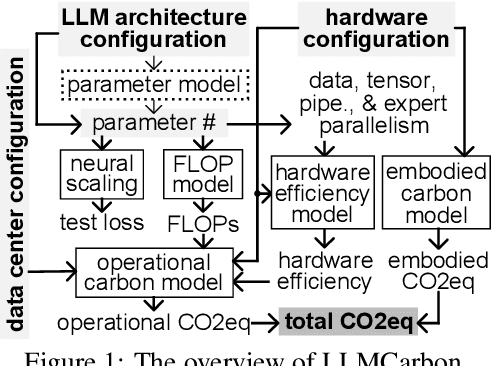Ahmad Faiz
IoTCO2: Assessing the End-To-End Carbon Footprint of Internet-of-Things-Enabled Deep Learning
Mar 16, 2024Abstract:To improve privacy and ensure quality-of-service (QoS), deep learning (DL) models are increasingly deployed on Internet of Things (IoT) devices for data processing, significantly increasing the carbon footprint associated with DL on IoT, covering both operational and embodied aspects. Existing operational energy predictors often overlook quantized DL models and emerging neural processing units (NPUs), while embodied carbon footprint modeling tools neglect non-computing hardware components common in IoT devices, creating a gap in accurate carbon footprint modeling tools for IoT-enabled DL. This paper introduces \textit{\carb}, an end-to-end modeling tool for precise carbon footprint estimation in IoT-enabled DL, demonstrating a maximum $\pm21\%$ deviation in carbon footprint values compared to actual measurements across various DL models. Additionally, practical applications of \carb are showcased through multiple user case studies.
LLMCarbon: Modeling the end-to-end Carbon Footprint of Large Language Models
Sep 25, 2023



Abstract:The carbon footprint associated with large language models (LLMs) is a significant concern, encompassing emissions from their training, inference, experimentation, and storage processes, including operational and embodied carbon emissions. An essential aspect is accurately estimating the carbon impact of emerging LLMs even before their training, which heavily relies on GPU usage. Existing studies have reported the carbon footprint of LLM training, but only one tool, mlco2, can predict the carbon footprint of new neural networks prior to physical training. However, mlco2 has several serious limitations. It cannot extend its estimation to dense or mixture-of-experts (MoE) LLMs, disregards critical architectural parameters, focuses solely on GPUs, and cannot model embodied carbon footprints. Addressing these gaps, we introduce \textit{LLMCarbon}, an end-to-end carbon footprint projection model designed for both dense and MoE LLMs. Compared to mlco2, LLMCarbon significantly enhances the accuracy of carbon footprint estimations for various LLMs.
 Add to Chrome
Add to Chrome Add to Firefox
Add to Firefox Add to Edge
Add to Edge